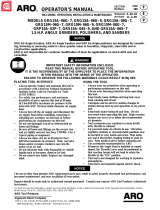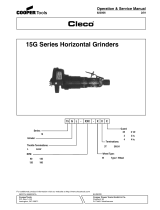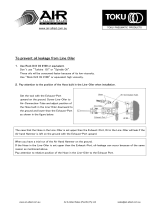
Product Safety Information
Failure to observe the following warnings, and to avoid these potentially hazardous situations, could result in death or serious injury.
Read and understand this and all other supplied manuals before installing, operating, repairing, maintaining, changing accessories on, or
working near this product.
Always wear eye protection when operating or performing maintenance on this tool. The grade of protection required should be assessed
for each use and may include impact-resistant glasses with side shields, goggles, or a full face shield over those glasses.
Always turn o the air supply, bleed the air pressure and disconnect the air supply hose when not in use, before installing, removing or
adjusting any accessory on this tool, or before performing any maintenance on this tool or any accessory.
Do not use this tool if the actual free speed exceeds the rated rpm. Check the free speed of this tool before mounting any accessories, after all
tool repairs, before each job and after every 8 hours of use. Check speed with a calibrated tachometer, without the abrasive product installed.
Note: When reading the instructions, refer to exploded diagrams in Parts Information Manuals when applicable (see under Related Documentation
for form numbers).
Lubrication
•
•
•
•
•
Each time a Series 99V Vertical Air Grinder is disassembled for
maintenance and repair or replacement of parts, lubricate the tool
as follows:
Inject approximately 1.5 cc of Ingersoll Rand No. 50 Oil into the
Inlet Bushing (5) after assembly. For models with a built-in oiler,
ll the chamber of the Oiler Assembly (23). After each eight hours
of operation, replenish the oil supply.
1.
If the Grinder is used in an extremely dirty environment, once in each
week or after each forty hours of operation, pour a liberal amount
of a clean, suitable cleaning solution into the slots in the handle. Work
the throttle lever vigorously to wash the cleaning solution around, and
then pour the solution and accumulated dirt from the handle. Repeat
this process until the cleaning solution is clean when it comes out
of the handle. Immediately after ushing with the cleaning solution,
inject a liberal amount of Ingersoll Rand No. 50 Oil in the slots and
again work the throttle lever vigorously to lubricate the cleaned parts.
2.
Oiler Adjustment (for models with built-in oiler)
The built-in lubricator has been properly adjusted at the factory. If
the oiler felts are clogged and must be replaced, proceed as follows:
Remove the grinding wheel. Remove the Cylinder Case
Screws (52), the Lock Washers (51), the Cylinder Case Gasket (48),
the two Motor Clamp Washers (47) and the Guard.
1.
With a thin blade screwdriver, remove the Oiler Adjusting
Screw (25) from the Oiler Assembly (23).
Using tweezers or a piece of bent wire, remove the Oiler Felts (24)
and install new ones.
Replace the Oiler Adjusting Screw, installing it slightly below ush.
2.
3.
4.
Disassembly
General Instructions
Do not disassemble the tool any further than necessary to replace
or repair damaged parts.
Whenever grasping a tool or a part in a vise, always use leather-
covered or copper-covered vise jaws to protect the surface of
the part and help prevent distortion. This is particularly true of
threaded members and housings.
Do not remove any part which is a press t in or on a subassembly
unless the removal of that part is necessary for repairs or
replacement.
Do not disassemble the tool unless you have a complete set of
new gaskets and O-rings for replacements.
Disassembly of the Motor
Grasp the Dead Handle (27) of the Grinder in leather-covered or
copper-covered vise jaws, Guard up.
Remove the Cylinder Case Screws (52), the Lock Washers (51), the
Cylinder Case Gasket (48), the two Motor Clamp Washers (47) and
the Guard.
Grasp the Arbor (29) in the vise and lift the Cylinder Case to
expose the motor.
Remove the Exhaust Silencer (39).
For models with a built-in oiler, take the tool from the vise and
dump the oil from its reservoir. The Oiler Assembly (23) can be
pulled from the Cylinder Case, if necessary.
Use only the special No. 99V60-950 Controller Wrench
for removing the Controller Assembly. Do not attempt to
disassemble the Controller. It is available only as a unit and is
guaranteed for the life of the tool if it is not abused.
The Controller Assembly (42) has a left-hand thread and the
Controller Nut (46) has a right-hand thread.
1.
2.
3.
4.
1.
2.
3.
4.
5.
6. Remove the Controller Nut and unscrew the Controller
Assembly (42).
7. Lift o the Rear End Plate (40) and Rotor Bearing Seal.
8. Lift o the Cylinder (36).
9. Remove the Vanes (35).
10. Withdraw the Rotor (34) followed by the Rotor Key (33).
11. Lift o the Front End Plate (31).
12. If the Front Rotor Bearing (30) is to be replaced, press it and the
Arbor from the Front End Plate. Press o the Bearing from the
Arbor.
13. Set the Controller on blocks in an arbor press. Using a round
piece of metal tting the inner race of the Rear Rotor Bearing,
press o the Rear Rotor Bearing Cage (45).
14. Insert the Controller into the 99V60-A952 Bearing Clamp and
tighten the nut on the xture. Insert the 99V60-A951 Seal
Pressing Tool in the center and press o the Controller. Release
the clamp.
Disassembly of the Throttle and Inlet for Models
without a built-in oiler
Place the Cylinder Case in the vise to remove the Inlet Bushing (5),
Inlet Bushing Screen (5A) and the Throttle Valve Spring (6). The
Bushing has an interference thread and is tightly t.
Drive out the Throttle Lever Pin (14) to release the Lever
Assembly (15).
Using a 3/32” hex wrench, reach inside the handle and remove
the Valve Seat Screw (13) from the Throttle Valve Seat Support
Assembly (7).
Thread a No. 8-32 screw about 5” (127 mm) long into the throttle
valve seat support in place of the removed valve seat screw. A
piece of 5/32” welding rod can be threaded on one end to serve
the same purpose.
Grasp the protruding end of the screw in a vise, and while tapping
lightly on the housing or handle with a plastic hammer, pull on
the housing or handle to withdraw the throttle parts.
The Air Strainer Screen (8) can now be removed and cleaned.
1.
2.
3.
4.
5.
6.










